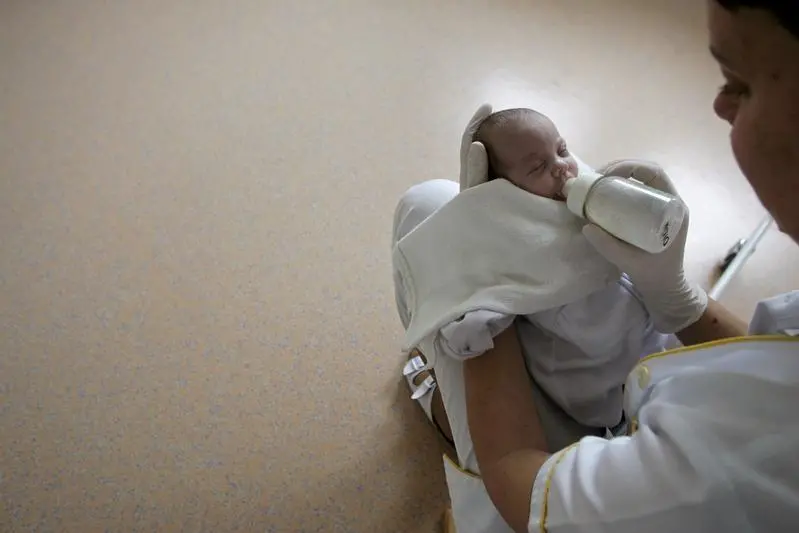PHOTO
By Scott Baltic
NEW YORK (Reuters Health) - At least some newborns with seemingly benign shudders or shivers could have vitamin D deficiency, suggests a new report on two cases, published in Pediatrics, online July 26.
Patient 1 was born in Washington, DC, via normal spontaneous vaginal delivery to a dark-skinned native of Barbados, who had lived in Washington for 15 years.
He was in the nursery for three days with mild jaundice and was exclusively breastfed. His mother reported taking prenatal vitamins and having no difficulty with breastfeeding.
On the initial newborn visit, at age 6 days, his mother’s only concern was that the baby shivered as if he were cold. Because the family lived in a basement, the child’s pediatrician simply advised the mother on how to clothe the baby.
At a follow-up visit at age 12 days, the mother reported worsening tremor in her child, which this time was evident during physical examination in the doctor’s office. The baby, however, had normal vital signs for his age and was alert, responsive and afebrile.
Laboratory results all were within normal limits, except for an alkaline phosphatase level of 430 U/liter (reference range, 30-65). Neonatal reflexes also were normal.
On subsequent testing, the infant was found to be deficient in 25 hydroxy vitamin D, at 6 ng/mL (normal, 30-100). He was started on vitamin D supplementation 800 IU daily. The mother, whose vitamin D level was later measured at 22.5 ng/mL, subsequently reported that she had not taken prenatal vitamins.
Within two weeks after starting treatment, Patient 1’s tremors subsided completely.
Patient 2, also born via normal spontaneous vaginal delivery, had a dark-skinned African-American mother who had received fair prenatal care, had taken prenatal vitamins, and then used formula to feed her infant.
Post-delivery examination of Patient 2 was remarkable only for the occasional shudder of the infant’s chin. Glucose screening was normal, but vitamin D was found to be only 17 ng/mL (normal, 30-100). Vitamin D at 800 IU daily was started, but this patient was lost to follow-up.
The authors, from Howard University Hospital in Washington, DC, note in their article that “neonatal tremors in otherwise healthy newborns have largely been assumed to be a benign neonatal characteristic that resolves spontaneously after a few months of life.”
They add that when tremors persist or worsen, diagnoses such as seizures, neurologic abnormality, hypoglycemia, hypocalcemia, hypomagnesemia, hyperthyroidism, drug withdrawal, and sepsis are considered.
“The assumption that neonatal tremors, in the otherwise asymptomatic healthy-appearing neonate, are benign, may be incorrect,” the authors conclude. They warn that neonatal tremor may be an early clinical sign of vitamin D deficiency and that such deficiency should be considered when tremors occur in a full-term neonate who lacks other indicators of pathology.
The report’s corresponding author did not reply to requests for additional information.
Dr. Maria Dizon, a neonatologist at Ann and Robert H. Lurie Children’s Hospital of Chicago, told Reuters Health in a phone interview that this study is “useful in raising awareness” of a possible connection between neonatal shudders and vitamin D deficiency, especially in children who are exclusively breastfed, whose mothers have darker skin, and who live at higher latitudes.
Dr. Chris Retajczyk, a neonatologist at California Pacific Medical Center in San Francisco, told Reuters Health by phone and in a follow-up email that this report was the first he had heard of noting a potential vitamin D connection with neonatal shudders. “I see a variety of newborns with any degree of movement abnormalities,” he said. They range from seizures that need to be investigated for a substantial pathology to less-intense movements that Retajczyk characterized as “pretty common” and “easily matched up with a clinical history,” such as a mother’s gestational diabetes and her newborn’s subsequent hypoglycemia.
“However,” he added, “there are frequently much more subtle movements in newborns that, although they are investigated for underlying sinister causes, never really pan out.” Therefore, he believes that vitamin D deficiency “will definitely be useful to add to the differential diagnosis.”
© Reuters News 2017












